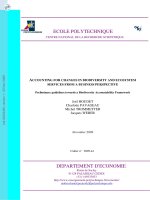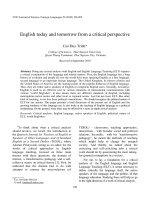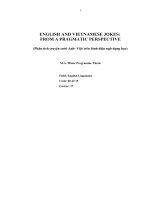Exploring the environmental variable from a cultural perspective through wayfinding behavior based on three chinese hospitals case studies
Bạn đang xem bản rút gọn của tài liệu. Xem và tải ngay bản đầy đủ của tài liệu tại đây (2.84 MB, 161 trang )
EXPLORING THE ENVIRONMENTAL VARIABLE FROM A CULTURAL
PERSPECTIVE THROUGH WAYFINDING BEHAVIOR
BASED ON THREE CHINESE HOSPITALS CASE-STUDIES
LU YI
(B. Arch., Southeast University, China)
A THESIS SUBMITTED
FOR THE DEGREE OF MASTER OF ARTS (ARCHITECTURE)
DEPARTMENT OF ARCHITECTURE
NATIONAL UNIVERSITY OF SINGAPORE
2005
Acknowledgements
This study was developed with the help of my thesis supervisor Professor Ruzica
Bozovic-Stamenovic, who supported me with expert sharpness. I am privileged and
great grateful to work with such a dedicated and considerate person. I am indebted not
only for her guidance in this thesis, but also for her support throughout my stay in
Singapore.
I am thankful to many people. I appreciate the 31 students from southeast university,
Nanjing who carried out the experimental task, as well as the helpful personnel of the
three hospitals. I give my sincere appreciation to the staffs and fellow research
scholars in Department of Architecture and Centre for Advanced Studies in
Architecture, NUS, for their kind suggestions and encouragements. Special thanks go
to the NUS for providing scholarship to facilitate me in this research. Finally, to my
family, I wish to thank them for their love, patience and continuous support.
i
Table of Contents
ACKNOWLEDGEMENTS ........................................................................................ I
TABLE OF CONTENTS............................................................................................II
SUMMARY ............................................................................................................... VI
LIST OF TABLES.................................................................................................. VIII
LIST OF FIGURES .................................................................................................. IX
CHAPTER 1:
INTRODUCTION............................................................................1
1.1
GENERAL STATEMENT .......................................................................................1
1.2
CULTURAL PROPERTY OF WAYFINDING PERFORMANCES ....................................4
1.3
HYPOTHESIS....................................................................................................11
1.4
METHOD OF INVESTIGATION ...........................................................................13
1.4.1
The method to quantify environmental variables .......................................................... 14
1.4.2
Case study ..................................................................................................................... 15
1.5
ORGANIZATION OF THE THESIS ........................................................................16
CHAPTER 2:
2.1
LITERATURE REVIEW..............................................................18
WAYFINDING ...................................................................................................19
2.1.1
Definition of wayfinding................................................................................................ 19
2.1.2
The previous empirical research ................................................................................... 20
2.2
ENVIRONMENTAL COGNITION..........................................................................23
2.2.1
Definition of environmental cognition........................................................................... 24
2.2.2
Contents of cognitive maps............................................................................................ 26
ii
2.2.3
Environmental properties in cognitive map................................................................... 27
CHAPTER 3:
THE CULTURAL ASPECTS OF THE ENVIRONMENT IN
CHINESE ARCHITECTURE ..................................................................................31
3.1
CULTURAL DIMENSION IN ENVIRONMENTAL COGNITION .................................32
3.1.1
Dao................................................................................................................................ 34
3.1.2
Confucianism................................................................................................................. 36
3.1.3
Feng-shui....................................................................................................................... 37
3.2
CULTURAL DIMENSION IN THE ENVIRONMENT .................................................40
3.2.1
Axiality and cardinal orientation .................................................................................. 41
3.2.2
Courtyard ...................................................................................................................... 43
CHAPTER 4:
THEORETICAL FRAMEWORK ...............................................47
4.1
TWO PARADIGMS OF ENVIRONMENTAL-BEHAVIOR STUDY ..............................47
4.2
THE PROPOSED FRAMEWORK OF WAYFINDING THEORY....................................50
CHAPTER 5:
CASE STUDY ................................................................................57
5.1
INTRODUCTION ...............................................................................................58
5.2
TECHNIQUE TO QUANTIFY CULTURAL ASPECTS OF AN ENVIRONMENT ..............60
5.2.1
Environmental Units...................................................................................................... 60
5.2.2
Cultural properties of environment ............................................................................... 62
5.3
TECHNIQUE TO QUANTIFY WAYFINDING PERFORMANCE ..................................66
5.3.1
Use of axial lines and nodes in open search.................................................................. 69
5.3.2
Redundant node use ...................................................................................................... 69
5.4
PHYSICAL EXPERIMENTS .................................................................................70
5.4.1
Description of research settings .................................................................................... 70
5.4.2
Subjects ......................................................................................................................... 89
iii
5.4.3
Procedures..................................................................................................................... 90
CHAPTER 6:
6.1
6.1.1
DATA ANALYSIS ..........................................................................92
INDEPENDENT VARIABLES ...............................................................................92
Integration central area ................................................................................................ 93
6.2
OPEN SEARCH AND ENVIRONMENTAL VARIABLES ............................................95
6.3
DIRECTED SEARCH AND ENVIRONMENTAL VARIABLES.....................................99
6.3.1
Correlation between amount of redundant use of each node and its integration value
and openness value ...................................................................................................................... 100
6.3.2
Correlation between amount of redundant use of each origin or destination and
integration and openness ............................................................................................................. 101
6.4
ANALYSIS OF THE SEARCH PATTERNS .............................................................103
6.4.1
The searching pattern in Nanjing Hospital ................................................................. 104
6.4.2
The searching pattern in General Hospital ................................................................. 109
CHAPTER 7:
DISCUSSION ............................................................................... 113
7.1
RESEARCH FINDINGS .....................................................................................113
7.2
COMPARISON OF THE FINDINGS WITH LITERATURE .........................................114
7.3
EXPLANATION ...............................................................................................116
CHAPTER 8:
CONCLUSION ............................................................................121
8.1
RESULTS OF THE STUDY ................................................................................121
8.2
THE CULTURAL DIMENSION IN WAYFINDING RESEARCH .................................122
8.2.1
The conceptualization of cultural dimension............................................................... 123
8.2.2
The role of cultural dimension in wayfinding research ............................................... 123
8.3
RESEARCH LIMITATIONS ................................................................................126
8.4
DESIGN IMPLICATIONS...................................................................................128
iv
REFERENCES.........................................................................................................130
APPENDIX A: SPACE SYNTAX THEORY......................................................134
APPENDIX B:
DATA ANALYSIS.......................................................................144
v
Summary
Wayfinding has become an important study subject in the field of EnvironmentBehavioral Studies and other related disciplines such as Urban Planning and
Architecture. Whereas, the environmental variables were argued to be of significance
in human’s wayfinding performance, it is difficult to integrate them in research and
obtain satisfying results. Cultural parameters in particular are rarely considered in
wayfinding theories or models. In the era of rapid economic growth, China is
undergoing rapid transformation in the built environment. Is there any relationship
between wayfinding performances and the traditional spatial pattern in modern China?
It should be understand that this study is a preliminary exploration. Therefore, the
purpose of this study is an attempt to capture ideas and to suggest future studies. Its
tone may be speculative and tentative.
It is proposed that wayfinding performance is relevant to the cultural properties of the
built environment. Therefore, this study focuses on chosen properties of the
environment that could be treated as part of the culture and could be analyzed as
relevant to the wayfinding performance in the selected settings.
This study employs knowledge and methods from EBS (Environment-Behavior
Study). First, a theoretical framework is to be built based on literature review and
theoretical arguments. Second, a field survey is to be conducted to observe and
vi
quantify the wayfinding behaviors of our subjects. The research was carried out in
three urban hospitals in Nanjing, a major Chinese city. The spatial units were
quantified by the space syntax software, according to their environmental properties
of axiality and openness; two typical and frequently discussed parameters chosen
among many others relevant from a cultural perspective.
In these three settings 31 participants, 17 male and 14 female students aged from 18 to
25, carried out the wayfinding tasks through open exploration of the settings and later
a directed search for certain destinations. The method used to describe the wayfinding
performance in this study was the quantification of the frequency of use monitored
through direct observation.
The results support our early hypothesis about the existence of the relationship
between search performance and environmental properties, which are described from
a cultural point of view. In other words, the analysis of the environmental properties
brought together the parameters of culture and the search performance. This suggests
that wayfinding performance could be affected by cultural characteristics immanent in
the Chinese society. The findings of this study are believed to inspire further research
in this direction, as well as to have important implication for hospital design. The
suggestion is to pay close attention to cultural issues related to the configuration of
hospitals, rather than to exclusively focus on only selected local characteristics, such
as signs and landmarks.
vii
List of Tables
Table 6-1 descriptive statistics of three critical environmental variables in these
hospitals: axial line integration (line int.), decision node integration (node int.),
and decision node openness (node op.).................................................................93
Table 6-2 Correlation (R value, P<.001) of integration values of axial lines with their
frequency of use in open search............................................................................96
Table 6-3 Correlation (R value, P<.001) of integration values of decision nodes with
their frequency of use in open search. ..................................................................96
Table 6-4 Correlation (R value, P<.001) of openness values of decision nodes with
their frequency of use in open search. ..................................................................97
Table 6-5 Correlation (R value, P<.01,*P<.05) of integration values and openness
value of decision node with their frequency of redundant use in directed search.
.............................................................................................................................100
Table 6-6 Correlation (R value, P<.01,*P<.05) of integration values and openness
value of origin and destination with the amount of redundant use in directed
search. .................................................................................................................102
viii
List of Figures
Figure 1-1 The physical feature of axiality and cardinal orientation. Source: (L. Wu,
1999) .......................................................................................................................7
Figure 1-2 The physical feature of courtyard. Source: (L. Wu, 1999)...........................8
Figure 1-3 The temple of Yang Bing Fang which was built in D.C. 717. Source:
(Luo,2001) ............................................................................................................10
Figure 1-4 The official hospital managed by government in D.C. 1229. Source: (Luo,
2001) .....................................................................................................................10
Figure 1-5 left is the plan of Children’s Healthcare Center in Shanghai, right is the
plan of people’s hospital in Fushan. Source: (Luo, 2001) ....................................13
Figure 2-1 contents of cognitive maps as found in literature.......................................28
Figure 3-1 The diagram indicated the relationship of Yin and Yan (Source:
/>Figure 3-2 a typical Feng-Shui diagram. Source: (Li, 2002).......................................38
Figure 3-3 Animal symbolism expressed in Feng-Shui. reproduction from an ancient
print. ......................................................................................................................40
Figure 3-4 Plan of house in Beijing, showing service quarters enlarged into a
courtyard of their own, separated from main courtyard, Source: (Boyd, 1962)...44
Figure 3-5 Houses of Han dynasty. Pottery models. Source: (Boyd, 1962) ................45
Figure 3-6 Simplified plan of Beijing, Inner and Outer Cities. Source: (Boyd, 1962)45
Figure 4-1 the integrated model of wayfinding knowledge.........................................51
Figure 4-2: the traditional wayfinding model ..............................................................53
Figure 4-3: the proposed wayfinding model................................................................54
Figure 5-1 examples of relations between environmental units according to Space
ix
Syntax theory. The middle indicates the convex spaces, while the right represent
the convex map of the plan. ..................................................................................60
Figure 5-2 the convex space ........................................................................................61
Figure 5-3 Axial map: it is composed of the smallest possible number of straight lines
that must be drawn in order to cover all the available connections from one
convex space to another. .......................................................................................61
Figure 5-4 Plan of General hospital. ............................................................................73
Figure 5-5 Site plan of General hospital (dark color indicates the hospital) ...............74
Figure 5-6 Axial map of General hospital of all rooms in the floor.............................75
Figure 5-7 Axial map of General Hospital of the main circulation system only. ........76
Figure 5-8 the decision nodes in General Hospital in circulation system only...........77
Figure 5-9 Plan of 81 Hospital.....................................................................................79
Figure 5-10 Site plan of 81 Hospital (Dark color indicates the hospital) ....................80
Figure 5-11 Axial map of 81 Hospital of all rooms in the floor...................................81
Figure 5-12 Axial Map of 81 Hospital of the main circulation system only................82
Figure 5-13 the decision nodes in 81 Hospital in circulation system only. .................83
Figure 5-14 Plan of Nanjing Hospital..........................................................................85
Figure 5-15 Site Plan of Nanjing Hospital (Dark color indicates the hospital) ...........86
Figure 5-16 Axial map of Nanjing Hospital of all rooms in the floor..........................87
Figure 5-17 Axial map of Nanjing Hospital of the main circulation system only. ......88
Figure 5-18 the decision nodes in Nanjing Hospital in circulation system only. ........89
Figure 6-1 Thick lines represent integration central area in 81 Hospital, the 20% of the
total number of spaces that rank highest according to the syntactic measure of
integration value of main circulation system. .......................................................94
x
Figure 6-2 the network composed of basic choice nodes defined within the circulation
system in Nanjing Hospital. There are 21 nodes giving three choices other than
backtracking within the total 38 nodes in Nanjing Hospital...............................105
Figure 6-3 the recorded tracks of the subjects who searched the back part of the
hospital first. .......................................................................................................107
Figure 6-4 the recorded tracks of the subjects who searched the front part of the
hospital first. .......................................................................................................108
Figure 6-5 the network composed of basic choice nodes defined within the circulation
system in General Hospital. There are 20 nodes giving three choices other than
backtracking within the total 39 nodes in Nanjing Hospital...............................110
Figure 6-6 the recorded tracks of the subjects in General Hospital in early stage..... 111
Figure 7-1 the wayfinding model composed of four parameters: the wayfinding
performances, the configurational variables of the setting, human’s cognition
ability, and cultural dimension............................................................................117
Figure B-1 correlation (R squared value, P<.001) of integration values of axial lines
with their frequency of use in open search in General Hospital .........................144
Figure B-2 correlation (R squared value, P<.001) of integration values of axial lines
with their frequency of use in open search in Nanjing Hospital.........................144
Figure B-3 correlation (R squared value, P<.001) of integration values of axial lines
with their frequency of use in open search in 81 Hospital..................................144
Figure B-4 correlation (R squared value, P<.001) of integration values of decision
nodes with their frequency of use in open search in General Hospital...............145
Figure B-5 correlation (R squared value, P<.001) of integration values of decision
nodes with their frequency of use in open search in Nanjing Hospital. .............145
Figure B-6 correlation (R squared value, P<.001) of integration values of decision
nodes with their frequency of use in open search in 81 Hospital. ......................146
Figure B-7 correlation (R squared value, P<.001) of openness values of decision
nodes with their frequency of use in open search in General Hospital...............146
Figure B-8 correlation (R squared value, P<.001) of openness values of decision
xi
nodes with their frequency of use in open search in Nanjing Hospital. .............146
Figure B-9 correlation (R squared value, P<.001) of openness values of decision
nodes with their frequency of use in open search in 81 Hospital. ......................147
Figure B-10 correlation (R squared value, P<.05) of integration values of decision
node with their frequency of redundant use in directed search in general Hospital.
.............................................................................................................................147
Figure B-11 correlation (R squared value, P<.01) of integration values of decision
node with their frequency of redundant use in directed search in Nanjing
Hospital. ..............................................................................................................148
Figure B-12 correlation (R squared value, P<.05) of integration values of decision
node with their frequency of redundant use in directed search in 81 Hospital...148
xii
Chapter 1:
Introduction
1.1 General statement
Wayfinding is not a term listed in Standard English dictionaries. Oxford English
Dictionary does not include it, nor does the Merriam-Webster Dictionary (Simpson et
al., 1993). However, wayfinding has become an important norm and study subject in
the field of EBS (Environment-Behavior Study) and other related disciplines such as
Urban Planning and Architecture since the 60s.
Wayfinding is commonly used to refer to the act of finding the route and destinations
in either outdoor or indoor environment. It also represents a person’s ability to
navigate and find a particular place within an environment. According to Golledge
(Golledge, 1999), “wayfinding is the process of determining and following a path of
route between an origin and a destination. It is a purposive, directed, and motivated
activity.”
From both theoretical perspective and everyday life experience, it is well known that
some buildings are easier to apprehend and to walk around in than others. It is
especially difficult for many people to find their destination within hospitals.
However, wayfinding design in hospitals surely imposes stress on our health and our
1
feelings. Patients and visitors represent a particularly vulnerable user group, for they
visit health care facilities under emotionally stressful and physically weak conditions.
True, human beings are tremendously versatile, we can transcend external influences,
but much of the time, most of us do not(Day, 2001). Therefore, at this time of their
life, they need a supportive and hospitable wayfinding environment in hospitals.
However, large and complex general hospitals are often like mazes, particularly for
the patients who visit infrequently(Altman, 1975; Carpman & Grant, 1993).
Despite much research done in hospital design theory, the wayfinding theory still
remains in its infancy. It is ambiguous both in the architectural and psychological field.
Actually, the impact of wayfinding difficulties can not be underestimated.
a. Dissatisfaction and tension
Disorientation and wayfinding in hospital buildings is a problem for some patients
and users. And this difficulty is being intensified as hospitals grow in size and
complexity. The stresses that people experience as a result of the bad wayfinding
design might have disastrous consequences. Kevin lynch takes a strong stand in this
point. He notes that to get completely lost is a rare occurrence but the feeling of
anxiety and fear that accompanies it will have direct influence on our sense of balance
and well being. Being unable to find one’s way leads to a feeling of helplessness and
frustration, and it obviously add to the stress of the patients who are weak in both
body and mind.
2
b. Inaccessibility and inefficiency
In our common understanding, the word ‘accessibility’ means ‘barrier-free’ design
facilities such as ramps and handrails. On the other hand, hardly anyone could deny
that psychological accessibility is also a valuable and desirable quality in health care
facilities.(Bell & Fisher, 1990) A good hospital building environment should therefore
avoid both physical and psychological barriers. Feeling being lost in a hospital, which
is widely aware by public, may deter a patient going into it. Just as what Carpman has
pointed out, the single thing that often worries the public about hospitals and health
care facilities might be getting lost in them.(Carpman & Grant, 1993)
c. Dangers
People who get into buildings also have to get out of them-some times fast. As the
hospitals grow larger and more complex, emergency evacuation and wayfinding
becomes a key problem related to a matter of life and death. A great deal of research
has been done on how people behave when confronted with the dangers of fire and
other emergencies. A legible floor plan and intuitive wayfinding environment surely
can help emergency evacuation if it is well understood by the users.
The supportive wayfinding environment, as discussed above, can benefit us at both
emotional and physical levels (Day, 1993). This helps patients especially during their
recovery and aid in their welfare. “Healing” means recovering from illness and
3
recuperating, a process that lead to health (Carpman & Grant, 1993). It is more than
just nourishing. However, good wayfinding environment is not just a need for those
who are ill. It is also for the healthy to make the most of living, thinking and doing.
We can all benefit from a supportive wayfinding environment (Day, 1993).
1.2 Cultural property of wayfinding performances
In the field of wayfinding theory, pervious researchers focus on three main aspects:
the environmental properties, cognition, and human wayfinding performance, which
also form the three main parts of this wayfinding research.
The wayfinding performance is the result of a two-way process between a person’s
cognitive ability and his environment. The environment suggests distinctions and
relations, and the wayfinder selects and organizes what he sees. Many kinds of cues
could be used for orientation.
Lynch believed people may use different elements of the environment, such as
“the visual sensation of color, shape, motion, or polarization of light, as well
as other sense such as smell, sound, touch, kinesthesia, sense of gravity, and
perhaps of electric or magnetic fields.”(Lynch, 1960, p3)
The systems of orientation which have been used vary widely from one culture to
4
another, from one landscape to another (Lynch, 1960) 1 .
They include “the abstract and fixed directional systems, the moving systems,
and those that are directed to the person, the home, or the sea. The environment
may be organized around a set of focal points, or be broken into names regions,
or be linked be remembered routes. Varied as these methods are, and
inexhaustible as seems to be the potential clues which a man may pick out to
differentiate his world, they case interesting side-lights on the means that we use
today to locate ourselves in out own city world.” (Lynch, 1960, p7)
Thus the wayfinding performances of a given environment may vary between
different wayfinders. One environment may be well-understood because it conforms
to a stereotype already constructed by the wayfinder even if it is visited for the first
time. Alternatively, one environment may be regarded as disordered by one person if
it has no physical features that suggest his own pattern.
For example, the islanders of Tikopia use the expressions inland or seaward for
all kinds of spatial reference, for the island is small enough. This reference
pattern is so strong that they have difficulty in conceiving of any really large land
mass. (Lynch, 1960, p128)
In the mind of traditional Chinese, there is also a spatial pattern to identify and to
structure the environment. There are some striking physical features which suggest
1
Please refer to the Appendix of this book to see examples of varied systems of orientation
5
this spatial pattern, such as pure geometrical forms, and a symmetry that mirrors the
alternation of summer and winter, day and night (Blaser, 1979, p. 9). They appeared
early in the tradition and were applied very widely, whether to the plan of a little
homestead, the layout of a temple, or even a city. These physical features could be
identified as axiality and cardinal orientation, the courtyard.
It must be granted that the discussion of the spatial pattern of traditional Chinese is
quite broad and complex. The physical features of axiality and cardinal orientation,
the courtyard are selected here because they are typical and inevitably discussed by
almost all pervious studies (Blaser, 1979; Boyd, 1962; Huang & Zurcher, 1995; S. H.
Lee, 1989; Li, 2002; Lung, 1978; C. A. Moore, 1986; Shen, 1994; Steinhardt & China
House Gallery., 1984; Wheatley, 1971; Xu, 2000; Yeh, 1986).
The first distinguished feature was cardinal orientation and axiality (Figure 1-1). It is
shared by almost every city, resident house and public building. In China, this pattern
appeared even “in the plans of some of earliest cities, but even the smaller cities and
towns usually exhibited the rule of cardinal axiality and orientation”(Shen, 1994). The
roads of a city ran from north to south or from east or west and divided it into a
rectangular grid. The enclosure walls, both of a city or its constituent parts, were the
most massive elements. In the Chinese city the principal street running from south to
north, was of much greater significance than any venue running from east to west.
Along axis were ranged the most important official building(Wheatley, 1971). This
6
feature dominances almost all buildings, ranging from Old City of Beijing to a single
residences.
Figure 1-1 The physical feature of axiality and cardinal orientation. Source: (L. Wu, 1999)
The second obvious feature is the layout of courtyard (Figure 1-2). Buildings, usually
rectangular in plan, were established around a courtyard or series of courtyards. Even
compact houses of two or more floors will often be found to be planned round a small
7
courtyard. Despite the different forms of individual buildings, the courtyard
composition is the most common.
Figure 1-2 The physical feature of courtyard. Source: (L. Wu, 1999)
Almost every building unit is planned to equally-sized open space. This is to obtain
the balance of Yin and Yang(S. H. Lee, 1989; Lung, 1978). Yin signifies the shadowy
slopes, the cold and rainy season, and everything that is passive and female; Yang the
sunny slopes, warmth and dryness and everything that is active and male. According
to Yin-yang school, yin and yang are interdependent, for there is no yang without yin
and no yin without yang.
8
Based on the above discussion, an environment may seem to be easily understood by
the traditional Chinese with the striking physical features which suggest his own
spatial pattern. There are definitely cultural conditions surrounding the environmental
cognition of traditional spatial concept, as well as the traditional environment (please
refer to Chapter 3 for detailed discussion on this issue).
For a historical perspective, the health care facilities in ancient China include three
types, charitable temple, official hospital, and private clinic.
Since the transmission of Buddhism, many people went to temples to seek
health care. Some patients lived within these temples because the temples
were far away from their residences. Therefore, some temples became the
charitable institution. For example, the Figure 1-3 describes the kind of temple
named Yang Bing Fang which was built in D.C. 717.In the D.C. 1229, the first
official hospital Yi Yuan was built in Su Zhou (Figure 1-4). It was a large
hospital with 70 buildings and 200 staff. Beside the official hospitals, some
doctors opened their own clinics in their homes. (Luo, 2001)
9
Figure 1-3 The temple of Yang Bing Fang which was built in D.C. 717. Source: (Luo,2001)
Figure 1-4 The official hospital managed by government in D.C. 1229. Source: (Luo, 2001)
10
However, all of these healthcare facilities followed traditional architectural principles,
such as axiality and cardinal orientation, the courtyard. There are no obvious
particularities in physical features compared to other traditional buildings. Therefore,
it could be speculated that people could comprehend the spatial organizations in
traditional hospitals. Hence, they have no difficult in the wayfinding issue.
However, in the era of globalization, the design of healthcare facility uses the
paradigm of modern architecture without considering cultural context. On the whole,
its cities are rapidly changing, and the people experience increased variety of
lifestyles and ways of thinking. This sudden transform of built environment has
opened up new questions. Does the uniqueness of the spatial pattern still exist? If the
answer is yes, is there any relationship between this spatial pattern and people’s
wayfinding performances? This question will also lead up to the purpose and
hypothesis of this study.
1.3 Hypothesis
The purpose of this study is to explore the relationship between the wayfinding
performances and the cultural property of the environment. In other words, is there
any relationship between wayfinding performances and the traditional spatial pattern
in modern China? It is proposed that wayfinding performance is still influenced by
prevalent cultural properties of people in a specific environment.
11
Before the discussion, it is important to remind the readers that this study is a
preliminary exploration. Therefore, the purpose of this study is an attempt to capture
ideas and to suggest future studies. Its tone may be speculative and tentative.
The reason to choose this agenda in this research could be explained by the following
phenomena.
Western ideologies strongly affect the process of recent architectural modernization in
Chinese hospitals since the 19th century. Most hospitals in China are built following
the “western paradigm and such health care spaces are undeniably accepted by the
Chinese society” (Rowe & Kuan, 2002). This approach placed relatively little
attention to the social-cultural context. This attitude is much explainable. One reason
is the newly founded local and national governments set out to modernize their
healthcare facilities. They followed available internationally modern design and
planning principles of hospitals. As a new type of architecture, the modern hospitals
combined with modern healthcare techniques and western medicine is accepted
quickly by most designers and planners in China (Figure 1-3).
12









